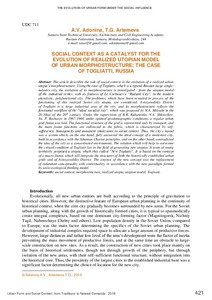Показать сокращенную информацию
SOCIAL CONTEXT AS A CATALYST FOR THE EVOLUTION OF REALIZED UTOPIAN MODEL OF URBAN MORPHOSTRUCTURE: THE CASE OF TOGLIATTI, RUSSIA
| Автор | Adonina, A.V. | |
| Автор | Artemeva ., T.G | |
| Дата внесения | 2019-07-10T08:56:30Z | |
| Дата, когда ресурс стал доступен | 2019-07-10T08:56:30Z | |
| Дата публикации | 2019-05 | |
| ISBN | 978-5-7638-4127-5 | |
| URI (для ссылок/цитирований) | https://elib.sfu-kras.ru/handle/2311/111714 | |
| Описание | Proceedings of the XXV ISUF International Conference “Urban Form and Social Context: from Traditions to Newest Demands” (Krasnoyarsk, July 5–9, 2018) | ru_RU |
| Аннотация | The article describes the role of social context in the evolution of a realized urban utopia’s morphostructure. Using the case of Togliatti, which is a typical Russian large single-industry city, the evolution of its morphostructure is investigated - from the utopian model of the industrial center, with its features of Le Corbusier’s “Radiant City”, to the modern pluralistic, polyfunctional city. The problems, which have been revealed in process of the functioning of this realized Soviet city utopia, are considered. Avtozavodskiy District of Togliatti is a large industrial area of the city, and its morphostructure reflects the functional workflow of the “ideal socialist city”, which was proposed by N.A. Milyutin in the 20-30ies of the 20th century. Under the supervision of B.R. Rubanenko, V.A. Shkvarikov, Yu. P. Bocharov in 1967-1968, under optimal geodemographic conditions, a regular urban grid-frame was laid. The functional structure of the grid is represented only by transport, and the main frame functions are redirected to the fabric, which is characterized by self-sufficiency, homogeneity and immanent intolerance to social context. Thus, the city’s layout was a system which, on the one hand, fully answered the ideal concept of a modernist city, built in accordance with the Athenian Charter principles, and on the other hand, contradicted the idea of the city as a concentrated environment. The solution which will help to overcome the critical condition of Togliatti lies in the field of generating new utopias. A team of young architects proposed a utopia, which they called “New Togliatti”. It is based on the concept of a macro frame, which will integrate the structures of both the historically established urban grids and of Avtozavodskiy District. The essence of the new concept was the replacement of redundant conceptuality with contextuality, in accordance with the new paradigm formed by socio-ecological thinking model. | ru_RU |
| Язык | en | ru_RU |
| Издатель | Siberian Federal University | ru_RU |
| Издатель | Сибирский федеральный университет | ru_RU |
| Тема | social context, morphostructure, realized utopia, utopian model, Togliatti. | ru_RU |
| Название | SOCIAL CONTEXT AS A CATALYST FOR THE EVOLUTION OF REALIZED UTOPIAN MODEL OF URBAN MORPHOSTRUCTURE: THE CASE OF TOGLIATTI, RUSSIA | ru_RU |
| Тип | Conference Item | ru_RU |
| Тип | Conference Paper | ru_RU |
| Контакты автора | Adonina, A.V., Artemeva, T.G. : Samara State Technical University, Architecture and Civil Engineering Academy, Russian Federation, Samara, Molodogvardeyskaya, 244 e-mail: tatart2@gmail.com, adoninanna@gmail.com | ru_RU |
| Страницы | 421 -429 | ru_RU |
| Место издания | Красноярск | ru |
| Место издания | Krasnoyarsk | en |

